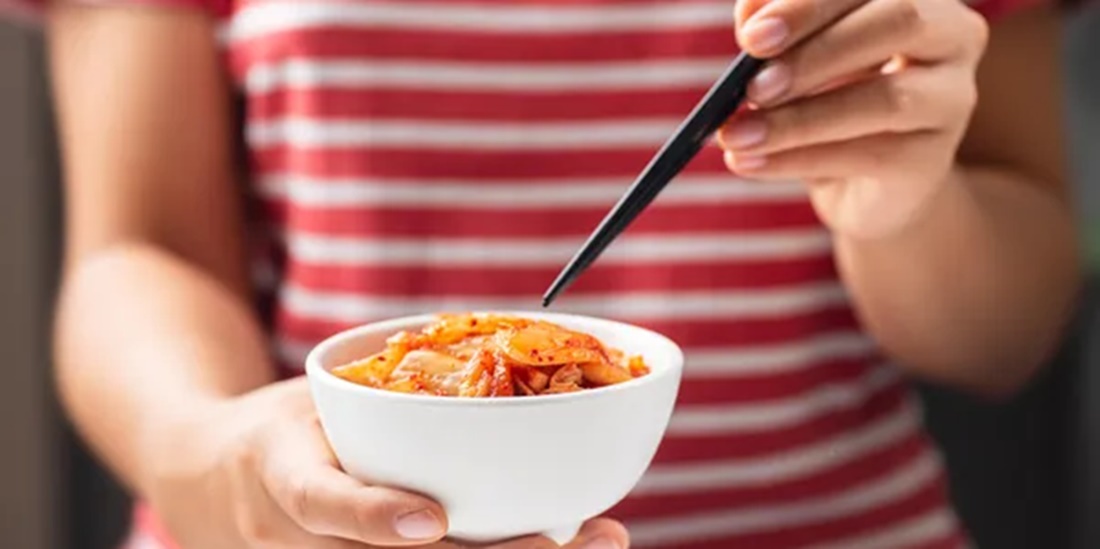Kimchi: One of the healthiest foods in the world
Thanks to valuable nutrients, Korean kimchi is considered one of the healthiest foods in the world.

The pickled cabbage not only stimulates digestion, it also activates the immune system.
What exactly is kimchi?
Kimchi is made from pickled Chinese cabbage, which is prepared by lactic acid fermentation. Sometimes leeks or radishes are also used.
In Korea, the bright red, hot and sour vegetable is served with almost every meal: as a soup or as an accompaniment to fish, meat or tofu. The traditional dish is considered a superfood because it contains few calories, many valuable vitamins (A, B1, B2 and C), fiber and minerals (calcium, iron).
This is how the fermentation process works
The process of making kimchi is similar to that of German sauerkraut. However, the Korean kitchen classic is not cooked, but eaten raw. This preserves vitamins and minerals.
The vegetables are first placed in salted water and then seasoned with ginger, garlic, fish sauce and chili. The cabbage leaves are then formed into small packets and stored in a closed jar for several days until the fermentation process begins. In this way, the vegetables will keep and after a few days will take on the typical sour-piquant kimchi taste.
Low in calories and aids in digestion
The health-promoting effect of pickled cabbage is scientifically proven. A 2014 study from the Journal of Medicinal Food found that kimchi, when consumed regularly, not only aids weight loss, but also lowers blood pressure and cholesterol levels, has an anti-aging effect, and boosts metabolism.
The lactic acid bacteria that develop during the fermentation process play a special role. They support digestion and have a positive effect on the intestinal flora and thus also on the immune system.
Cell receptor sends signals to the immune system
For a long time it was unclear which chemical processes in the body are responsible for the immune-stimulating effect of fermented foods. A study at the University of Leipzig has now been able to show how the interaction between lactic acid and the immune system works. The research team led by study leader Claudia Stäubert discovered that the lactic acid bacteria send signals to a specific cell receptor (HCA3), which activates the immune system.
“Countless studies show positive effects mediated by lactic acid bacteria and fermented foods. We are convinced that the HCA3 must be responsible for some of these effects”. Based on this finding, the researchers want to conduct further studies to develop new drugs to treat intestinal diseases.
Vitamin C strengthens the immune system
But not only the lactic acid bacteria in kimchi support the body’s defenses, but also its vitamins. Vitamin C, which is found in large quantities in cabbage, plays an important role in this.
As an antioxidant, it switches off aggressive free radicals (cell-damaging oxygen compounds) that occur in the body and can lead to diseases. According to the Federal Institute for Risk Assessment (BfR), the antioxidant effect of vitamin C is of great importance for the immune system.
Recipe: Make-your-own kimchi
There are countless ways to make kimchi in Korean cuisine. Every taste nuance is represented, from mild to spicy-hot.
For the basic recipe (5 servings) you need the following ingredients:
1 Chinese cabbage
1 tbsp rice flour
1 tbsp cane sugar
5 cm ginger
4 sticks of spring onions
4 crushed garlic cloves
2 tbsp chili powder
1 tbsp fish sauce
1 carrot
1 radish
1 bunch of chives
100 grams of salt
To prepare, proceed as follows:
Halve the Chinese cabbage and place the halves in a bowl of water for a few minutes. Then cut the cabbage into individual leaves and salt them carefully. The salted cabbage leaves should rest for about two hours, turning frequently.
In the meantime, mix the rice flour with a cup of water in a saucepan and bring to the boil. Pour the flour mixture into a large bowl, stir in the sugar and set the bowl aside.
Then chop the ginger and garlic, add both to the flour mixture and mix everything with the chili powder and the fish sauce. Now cut the carrot, radish, spring onions and chives into very thin strips and mix them in as well. Finally season the mixture with salt.
Once the cabbage leaves have steeped long enough, rinse them thoroughly under running water and squeeze them out. The rice mass is now distributed on the cabbage leaves. Then layer them tightly together in a sealable, airtight container.
Finally, pour the remaining rice flour and vegetable mixture over the leaves and leave to ferment at room temperature for three to five days.
When the fermentation process is complete, kimchi is ready and can be placed in the refrigerator for storage. It stays there for two to three months.


